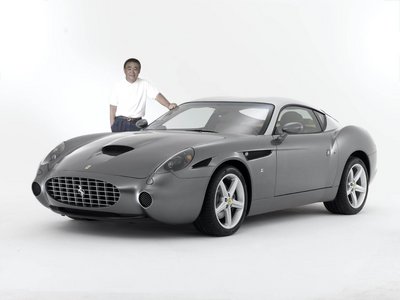Ferrari 575 GTZ Zagato

As with the original 250 GTZ, the 575 GTZ is finished with two-tone paintwork, although the metallic grey shades are far more subtle than the inspiration’s blue and white scheme which was originally commissioned by Galluzzi as a compromise solution because his wife hated Spiders. Despite its good looks, the original was commissioned as a stylish grand tourer and a competition car in one. Due to this dual purpose, Galluzzi ordered the car with hip-hugging bucket seats.
Exclusive: First official picture of the Ferrari 575GTZ. Rarity has to be the key word, as it is so rare to find a modern car as beautiful and so pure as the new Ferrari 575GTZ by Zagato.
The background behind this fascinating project materialised when legendary Japanese car collector Yoshi Hayashi asked Zagato if it would be possible to create special bodywork for his 575M Maranello in the style of the famous 250GTZ berlinetta (0515). For Zagato this represented a new chapter in their long tradition of creating exclusive bodywork around Ferrari mechanicals, starting in 1948 with the 166 Sport. Yoshiyuki Hayashi currently owns several Ferrari’s, including a 166MM, a 250 Spider California, two Daytonas – a coupe and spider – and an Enzo. He has also owned other famous models, including 250 GTOs (3413GT and 3705GT), a 250 LM (26105) and 250 TR Spider Scaglietti, so his passion towards the Ferrari 250 model in particular is probably unparalleled.
When Zagato received Hayashi’s bespoke request to sculpt an aluminium body around a 575M Maranello along the lines of the classic model, the coachbuilder informed Ferrari of the project as it provided a perfect opportunity to celebrate the original 250GTZ’s 50th anniversary.
The original 250 GTZ represented Zagato’s first bodywork commission for the Ferrari 250, and has also remained the most admired. Originally made to order by gentleman racer and construction magnate Vladimiro Galluzzi to pacify his wife, the 250 GTZ represented the fourth Ferrari model to sport Zagato bodywork. The design was created from a blank sheet of paper by engineer Fabio Luigi Rapi, with styling touches from Ugo Zagato who at the time was starting on the Lancia Appia and decided that the two cars should therefore share similar styling treatment. The result was stunning in beauty and highly advanced at the same time.
True to its forbearer, the new 575 GTZ perfectly captures the sleek lines, which at the time showcased an exceptionally low nose for aerodynamic reasons. Both cars also share similar muscularity with the rear wheel arches, providing the impression of streamlining and strength. Perhaps one of the most striking features of the 250GTZ, which was not implemented on the 575GTZ, is the stepped rear C-post which was introduced purely for styling reasons to make the car instantly recognisable. However, the trademark double bubble roof, that was first seen in 1954 on Zagato’s Fiat 8V, is present on both of the GTZs. The form of the double bubble roof is much stronger than that of a conventional alternative, allowing Zagato to use a lighter gauge of aluminium. On the original 250 GTZ, the roof used 1.0-1.2 mm aluminium, where as the typical standard lay at 1.5-1.6 mm.
- By James Granger
- Provided by Source